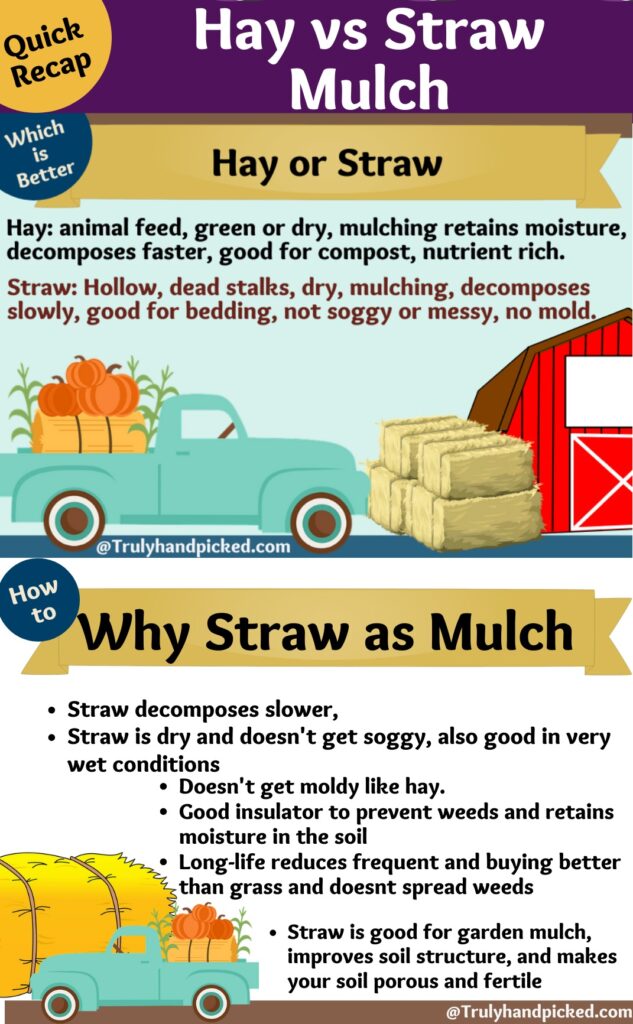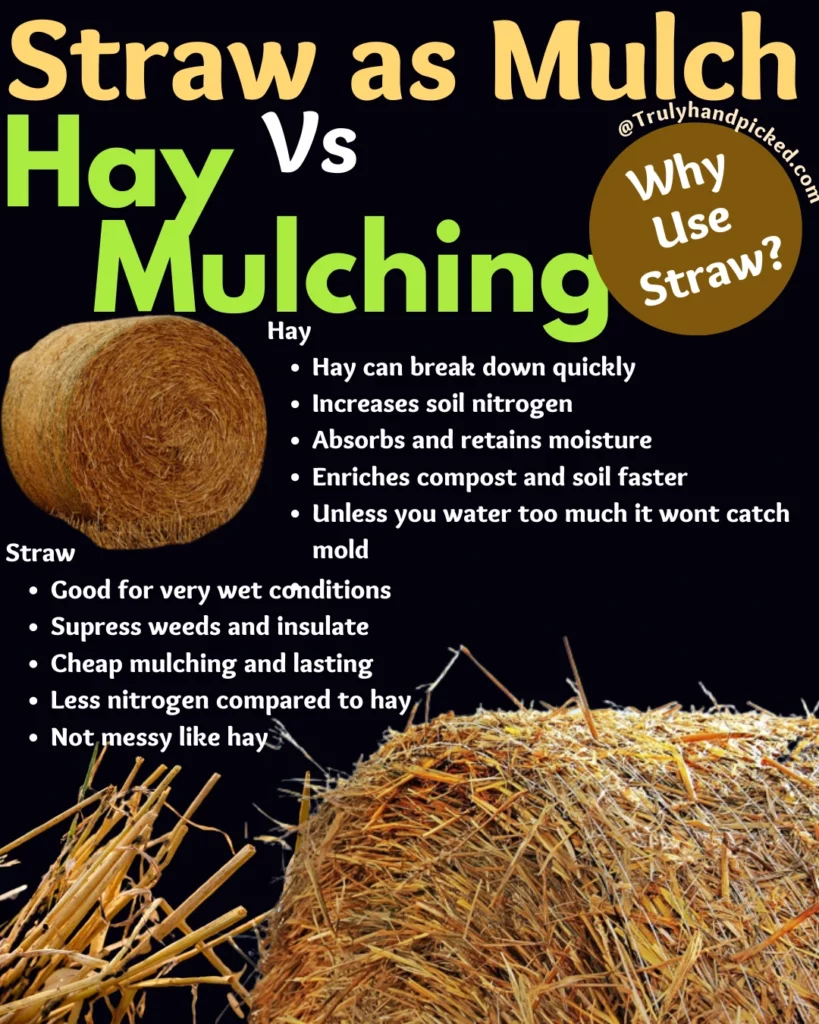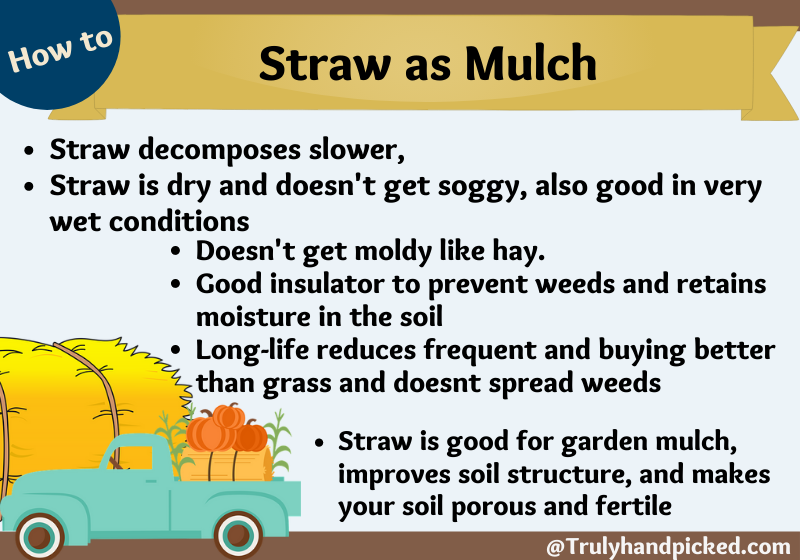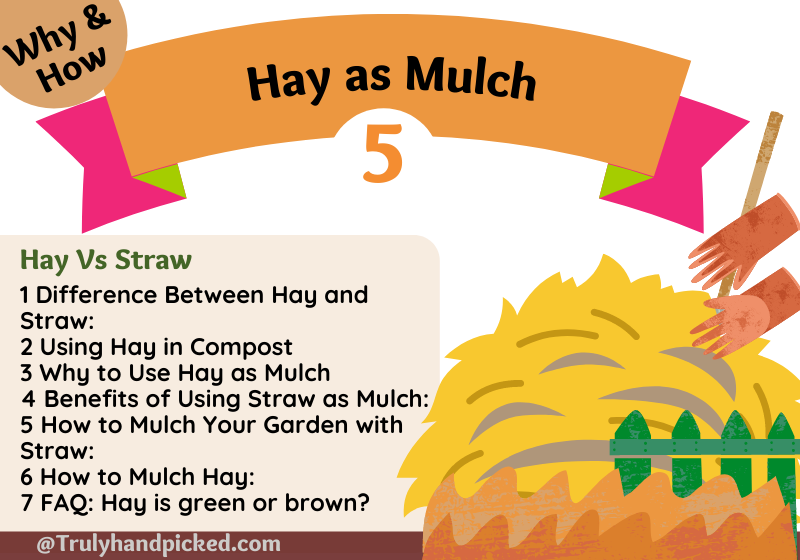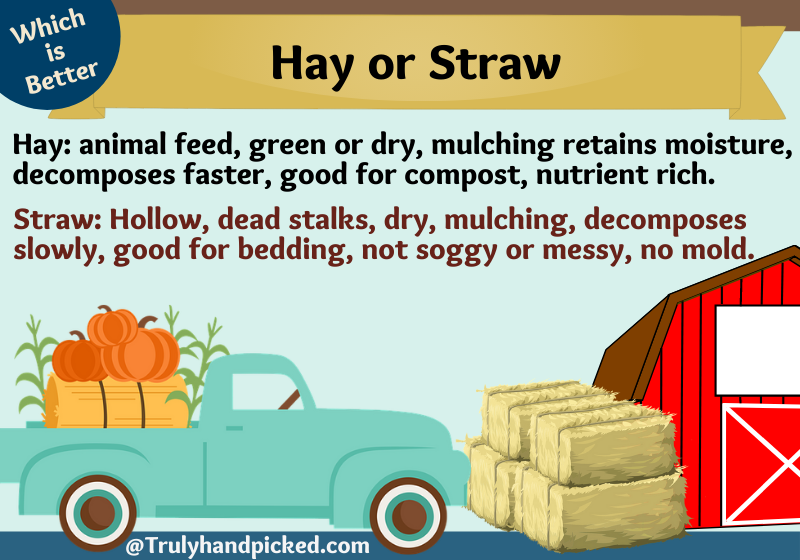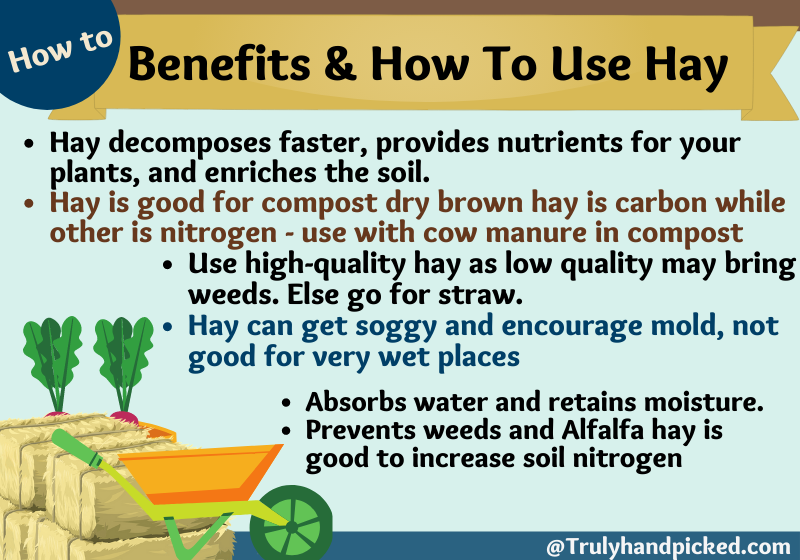Most serious gardeners know how much mulching is important for healthy gardening. As mulching improves the whole nourishment process of your plant by holding moisture and preventing weeds. However, some landscapers seem afraid of using the right element for mulching.
Hay turns out to be a better mulch if it’s free from seeds and of high quality as it is nice for mulching and insulating to keep weeds off your bed.
It is not pleasing in terms of the dry and beautiful cover but layers of hay mulch are nourishing for your garden bed with veggies and flowering plants.
If it’s alfalfa hay it’s even better and as it breakdowns, it nourishes your soil nutrients with enriches the garden with nitrogen.
Hay turns out to be a good soil amendment and composting materials use it as mulch and spread loose hay around your vegetable, flower beds, and trees it is up to 4 inches deep.
Over hay bales, straw is a better mulching material in terms of keeping the chances of weed seeds down. Also straw is a good choice for bedding rather than hay which may turn dirty.
Also if your compost is already loaded with nitrogen, using a straw is a better option rather hay again which is high in nitrogen.
Straw mulch is good for very wet conditions, and it’s light, mold-free, cheap, weed-free, and dry, and a good insulator that lasts longer than similar mulching materials. Straw decomposes slowly so know it before you toss it in your compost.
Why & How to Use Straw as Mulch
Benefits of Using Straw as Mulch:
Like hay mulching, straw mulch has its benefits and can make your gardening experience easier than ever with its obvious advantages. Let’s see how straw mulching benefits our garden plants ideally-
- Straw mulching helps you to reduce the frequent watering process noticeably
- You don’t even need to water your vegetable plants more than once a week, once you start using straw for mulching
- Straw is good for garden mulch, improves soil structure, and makes your soil porous and fertile
- Straw prevents the roots get dry even during the scorching period of summer
- By holding the sun rays along with water, straw averts weeds and unwanted plants from germinating around your garden plants – straw bale used for weeds
- As straw retains the moisture for a long, it let the soil texture soft and helps the root system spread more effortlessly
- Typical soil base gets dry more quickly than straw mulching and thus, can retain the water for more than 3-4 days easily
- Straw mulch diminishes pests and common diseases from your plants effectively
- It helps from preventing blossom-end rot in some vegetable plants
- The thickness of the straw provides a blanket layer over some large veggies like pumpkin or squash and lets them grow unblemished
- As soon as straw starts decomposing around the plants, it releases a high level of nutrients that let your plants thrive better
- And straw mulching helps you to fight the poor-soil quality for any outdoor gardening.
Related: Homemade organic plant foods
How to Mulch Your Garden with Straw:
After witnessing the plenty of benefits of this straw mulching, you must seek the right process of using straw, right. So, here we go with that technique in our discussion below in step-by-step methods-
- Gather some fresh straw for mulching and decide the area fight to mulch with this component
- Once you plant the seeds into your garden soil, pat the soil and keep the around place clean from any kind of weeds or unwanted grass
- Now leave the exact spot where you sow the seeds and spread the layer of straw around it as mulch
- If you are mulching around a grown plant or seedlings, leave a circle around the stem that forms from the ground
- Finally, mulch the soil with straw with a 5-6 inch layer and water thoroughly to get its mulching benefits accordingly.
How to get rid of weeds in your garden
How to Use Hay as a Mulching Material
They mostly get confused between the two most commonest mulching components straw and hay. So, let’s find out some details about these typical mulching products along with their advantages in our article below. This will help you to decide, which is the best for your garden plants-
Related: Nitrogen-boosting organic wastes for your garden
Straw vs Hay as Mulch
Difference Between Hay and Straw:
A sharp gardener must know that hay is not straw. Despite both being mulching options, some apparent differences always remain between these two. Some of the must-known variances between hay and straw are as follows-
- Hay is a field grass, while straw is the dry hollows of some cereal crops
- It is mostly grown and cut for livestock, while straw mostly comes from harvested cereal yield like barley or wheat
- Hay can be stocked in both green or dry forms, while straw is mostly used in dried form
- You can cut hay when some of the grasses are going to seeds, but straw almost has no seed heads, when compared to hay
- Hay can break down quickly and easily, while straw is quite slow to decompose
- It is low in nutrition value than straw as hay is a simple field grass, while straw is by product
- Low-quality hay contaminates weeds and unwanted wildflowers in your plant base, while straw never encourages such a thing to your plants.
- And hay is mostly grown and harvested to feed farm animals, while straw can be made from crops that are grown for different purposes.
Quick tips to enrich your garden soil with mushroom compost – How to use mushroom compost
How to Use Hay in Compost
You can use hay in the compost bin to increase the nutrition value and carbon content in your compost pile. There are some must-known facts to use hay in compost to clutch the benefits of this product more deeply in your compost mound. These are-
- Always use spoiled hay to use this product in your compost pile
- Try to combine spoiled hay with cow manure with a ratio of 0.8:1.0 for the best result
- Absorbs water and retains moisture
- Wait for the windrow formation to mix hay in your compost bin
- Check for the carbon and nitrogen level of your compost pile to decide the perfect ratio of hay to be mixed in your compost bin
- And remember that hay takes 2-4 months to decompose, so, mix it in your compost pile only if you can wait for that much.
How to use banana peels & use eggshells in compost
Why Use Hay as Mulch
Hay is a variety of herd grass, basically belonging to the category of field grass. This is a tall field grass, named timothy, and grows seed heads while grown fully. The stalks grow leaf beds and seem baled bales in rectangular shapes when dried.
This product always topped the list of mulching among its other equivalents. There are some specific benefits we always find from hay mulching instead of normal mulch. Some advantages that make hay better than normal mulches are-
- Hay breaks down more quickly than normal mulch due to its soft and dense texture
- Unless you water the mulch too heavily, it doesn’t get moldy
- Mulching it rapidly creates a rich coating of nutrients around the base of our plant
- Hay starts composting more quickly with or without cow manure and applied fertilizer layer
- Hay mulch provides the best benefit to seeds and seedlings and most of the starter plants
- And hay soaks up moisture quickly but provide warm as well as nutritious cover that helps plant to thrive brilliantly.
Step-by-step tips on how to plant seeds and take care of a lawn
How to Mulch Hay:
Mulch your garden with hay to give your plants a boost start, especially if you are doing flower or vegetable gardening. Hay mulching is not always eye-pleasing to resemble, but it has particular advantages. Let’s learn how to use hay as a mulch for your garden plants like a pro gardener-
- Decide the spot where you need to grow your garden plants and cover the area with hay mulching
- Try to keep the layer of hay up to 8 inches thick and cover the entire garden bed area with this coating
- Now you can clear spots and sow seeds or plant seedlings or starter plants through the hay layer and watch them grow
- Try to pick the best quality hay for mulching if you want to make your yield fertile and free from weeds for any kind of gardening.
Mulching can also help to get rid of horsetail weeds in your garden.
FAQ: HAY & Straw as Mulch
Is Hay Brown or Green in Compost?
A healthy compost pile always needs a perfect combination of carbon and nitrogen-rich hay. Brown hay is carbon-rich, while green item is high in nitrogen. Try to put dried brown materials instead of green grass clippings into your compost pile to avoid getting a smelly compost bin.
Pinterest Image on Hay or Straw for Mulch
